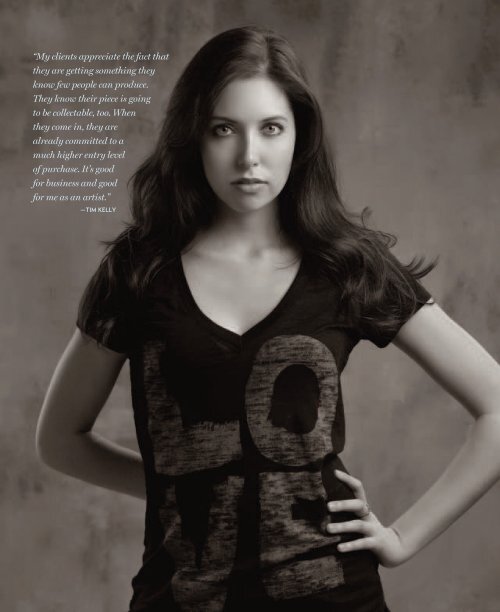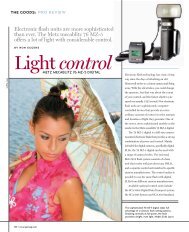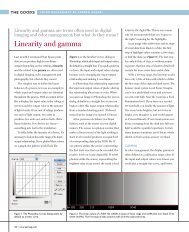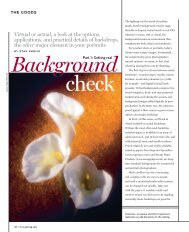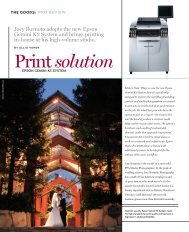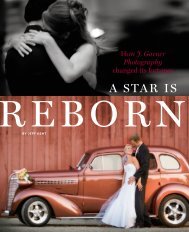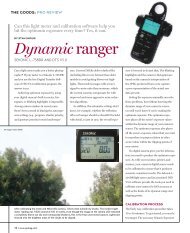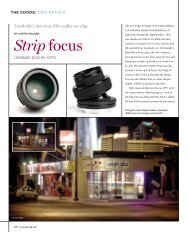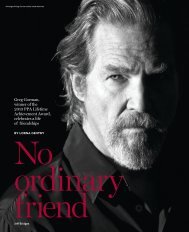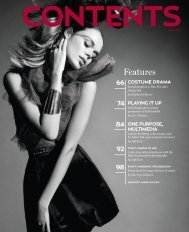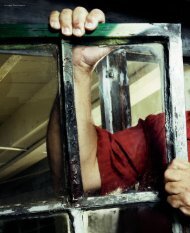Tim Kelly Looks Back to Go Forward
Tim Kelly Looks Back to Go Forward
Tim Kelly Looks Back to Go Forward
Create successful ePaper yourself
Turn your PDF publications into a flip-book with our unique Google optimized e-Paper software.
“My clients appreciate the fact that<br />
they are getting something they<br />
know few people can produce.<br />
They know their piece is going<br />
<strong>to</strong> be collectable, <strong>to</strong>o. When<br />
they come in, they are<br />
already committed <strong>to</strong> a<br />
much higher entry level<br />
of purchase. It’s good<br />
for business and good<br />
for me as an artist.”<br />
—TIM KELLY
All images ©<strong>Tim</strong> <strong>Kelly</strong><br />
<strong>Tim</strong> <strong>Kelly</strong><br />
reaches back <strong>to</strong><br />
move forward<br />
Adaptation<br />
BY ERIC MINTON
T<br />
one<br />
mitted <strong>to</strong> a much higher entry level of purim<br />
<strong>Kelly</strong>, M.Pho<strong>to</strong>g.Cr., F-ASP, is looking ahead—<strong>to</strong>ward<br />
his immediate future in the Orlando, Fla., market where<br />
his portait studio is located, and far beyond <strong>to</strong> his legacy. To get a clear view,<br />
though, he’s looking deep in<strong>to</strong> his past. The New Jersey native, who started<br />
working in a pho<strong>to</strong>graphy studio in 1968, has run <strong>Tim</strong> <strong>Kelly</strong> Portraits in<br />
form or another since 1978. Two years<br />
ago, he embarked on the business’s latest<br />
incarnation as a high-end, film-based studio<br />
working with the Fine Artists Management<br />
agency in Atlanta <strong>to</strong> secure and vet clients.<br />
That agency’s name is indicative of <strong>Kelly</strong>’s<br />
thinking about his new business model, one<br />
akin <strong>to</strong> visual artists in other mediums. “That<br />
was a big, big change, <strong>to</strong> step out of retail and<br />
handle the business like a fine artist,” he says.<br />
“I needed <strong>to</strong> find a vehicle for what I wanted<br />
<strong>to</strong> create, what I wanted <strong>to</strong> be, what I wanted<br />
<strong>to</strong> do every day. For me, anything that resembles<br />
retail was something I didn’t want. I<br />
couldn’t take another ‘What’s the 8-by-10<br />
charge?’ or having <strong>to</strong> prove <strong>to</strong> a senior’s<br />
mom that I’m worth what I charge.”<br />
This was a calculated decision as much as<br />
a heeding of his heart. His business—which<br />
includes a cus<strong>to</strong>mer service rep, a studio<br />
assistant, a re<strong>to</strong>uch artist, and a video department<br />
run by his son—halved its volume of<br />
clientele, which might have happened anyway<br />
given current economic and industry<br />
conditions, <strong>Kelly</strong> suggests. Even so, he’s filling<br />
a lucrative niche with limited competition<br />
in selling large-format art portraits in<br />
the form of pho<strong>to</strong>gravures, platinumpalladium,<br />
and silver prints.<br />
“My clients appreciate the fact that they<br />
are getting something they know few people<br />
can produce,” says <strong>Kelly</strong>. “They know<br />
their piece is going <strong>to</strong> be collectable, <strong>to</strong>o.<br />
When they come in, they are already com-
chase. It’s good for business and good for<br />
me as an artist.”<br />
<strong>Kelly</strong>, who has a portfolio of award-winning<br />
work from 45 years in the business, is<br />
pointing both his business and artistic compasses<br />
<strong>to</strong>ward galleries and print sales, both<br />
of which had long been sidebars <strong>to</strong> his studio<br />
business. By his estimate, <strong>Kelly</strong> is spending a<br />
quarter of his time “honing my ultimate<br />
portfolio,” with an eye <strong>to</strong>ward a new exhibit<br />
and book. He’s gone back <strong>to</strong> the darkroom <strong>to</strong><br />
reprint his collection in platinum-palladium.<br />
“Platinum has no enemies; the prints last<br />
forever,” he says. “It takes more skill and labor<br />
<strong>to</strong> do it, but those prints are highly valued.”<br />
<strong>Kelly</strong>’s ideal clientele includes collec<strong>to</strong>rs<br />
and galleries in addition <strong>to</strong> studio cus<strong>to</strong>mers.<br />
“I’m already making clients happy, so I’m<br />
working <strong>to</strong>ward a body of work that will go<br />
on after I do,” he says. Even with the cut in<br />
volume, he figures his studio work will yield<br />
a half-dozen images a year that could end up<br />
among his collectible prints.<br />
NEW AGAIN<br />
<strong>Kelly</strong> was an early convert <strong>to</strong> digital pho<strong>to</strong>graphy,<br />
but when it became ubiqui<strong>to</strong>us,<br />
he found a new competitive edge: “I’m<br />
going back <strong>to</strong> what I love most, handmade<br />
work.” Black-and-white prints became his<br />
primary product about three years ago.<br />
Then he built his own wet darkroom so he<br />
could produce silver and platinum prints.<br />
In addition <strong>to</strong> his 4x5 <strong>Go</strong>wlandflex twinlens<br />
reflex camera, another key piece of his<br />
“new” equipment is something he bought<br />
as office decor about the time he went filmless:<br />
an 8x10 Century No. 7 Studio Camera.<br />
He had the lens and shutter serviced and a<br />
flash sync added.<br />
“I’m not a gear hound at all. I use what<br />
works,” he says. “If I don’t use something in
a year, it’s gone.” He uses Pho<strong>to</strong>genic lighting<br />
and Larson soft boxes, and he has<br />
designed some of his own backgrounds,<br />
but most of his current favorites are from<br />
<strong>Back</strong>grounds by Mahue.<br />
He has s<strong>to</strong>ckpiled Polaroid PN55 positive/<br />
negative film <strong>to</strong> use in the <strong>Go</strong>wlandflex. “It<br />
provides a negative and a print, so I have<br />
both at once and I know I’m satisfied,” he<br />
says. Of course, not only is Polaroid extinct,<br />
the film itself is outdated. “You buy boxes<br />
and you’re not sure it works,” <strong>Kelly</strong> says. He<br />
uses it sparingly. He’s also shooting with<br />
4x5 Kodak film, but when the PN55 disappears<br />
completely, it will be a sad day for the<br />
artist in <strong>Kelly</strong>. “It’s just a beautiful film. But<br />
when it goes, it goes.”<br />
A SMILE IS JUST A SMILE<br />
<strong>Tim</strong> <strong>Kelly</strong> uses a standard when it comes <strong>to</strong> smiling that he takes from the old masters<br />
of portrait painting: You’ll seldom see any teeth. “Most of my people are not smiling. It<br />
gives you a more powerful piece.” One benchmark of great art is how long it holds the<br />
viewer’s attention, says <strong>Kelly</strong>. “If it’s smiling at me, three seconds. If it’s contemplative,<br />
I look at it longer.” He points out that portrait painters of old never showed teeth in<br />
their paintings. Mona Lisa’s fame is largely due <strong>to</strong> her enigmatic smile.<br />
IT’S ART AS USUAL<br />
<strong>Kelly</strong> says he has always approached pho<strong>to</strong>graphy<br />
as an art; it’s the business around<br />
it that changes. “I’ve always drifted in<strong>to</strong> art<br />
and back in<strong>to</strong> retail and back and forth.”<br />
From 1988 <strong>to</strong> 1990 he had a high-end<br />
studio and gallery on Park Avenue in Winter<br />
Park, Fla., and a business model similar<br />
<strong>to</strong> his present one. “I wouldn’t meet a client<br />
until they had a contract for a portrait,”<br />
<strong>Kelly</strong> says. “I was an aloof artist back<br />
then.” Though the venture was successful,<br />
he decided he didn’t like the s<strong>to</strong>refront<br />
location. He built a 2,400-squarefoot<br />
gallery and studio behind his house,<br />
which he continues <strong>to</strong> use. While <strong>Kelly</strong>’s<br />
business has long been a high-end portrait<br />
studio, over time it drifted back in<strong>to</strong> a more<br />
retail-like shop.<br />
“It’s now time <strong>to</strong> reinvent ourselves again,”<br />
he says, “which is <strong>to</strong> my design and delight.” ■<br />
See more of <strong>Tim</strong> <strong>Kelly</strong>’s work at<br />
timkellyportraits.com.<br />
Eric Min<strong>to</strong>n is a writer and edi<strong>to</strong>r in<br />
Washing<strong>to</strong>n, D.C.<br />
64 • www.ppmag.com


